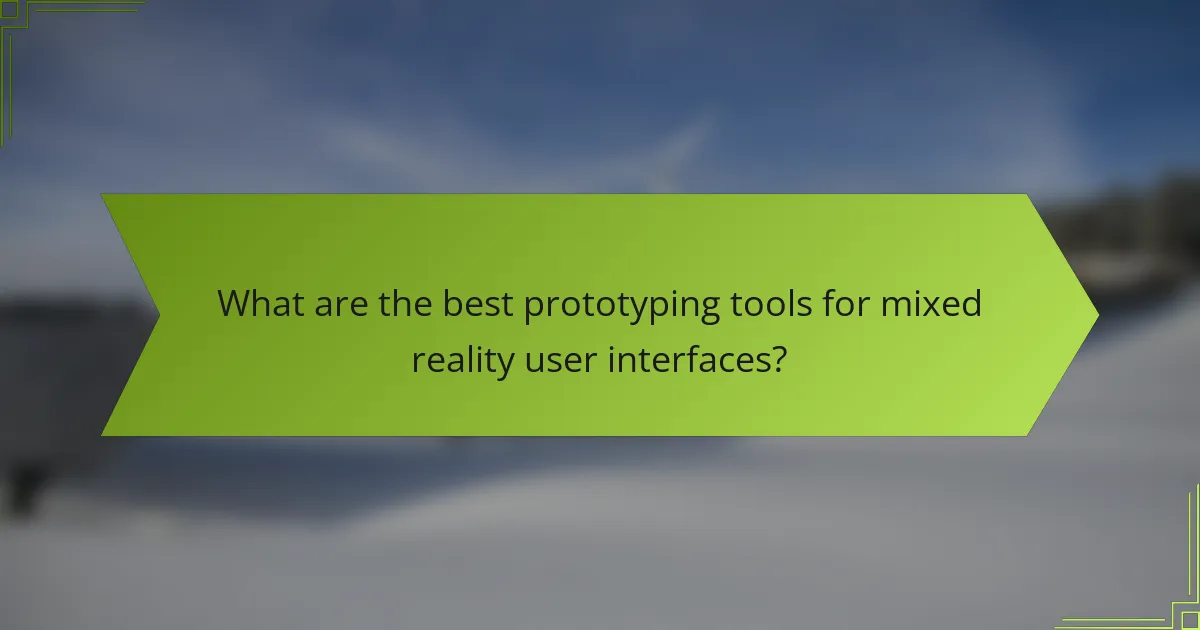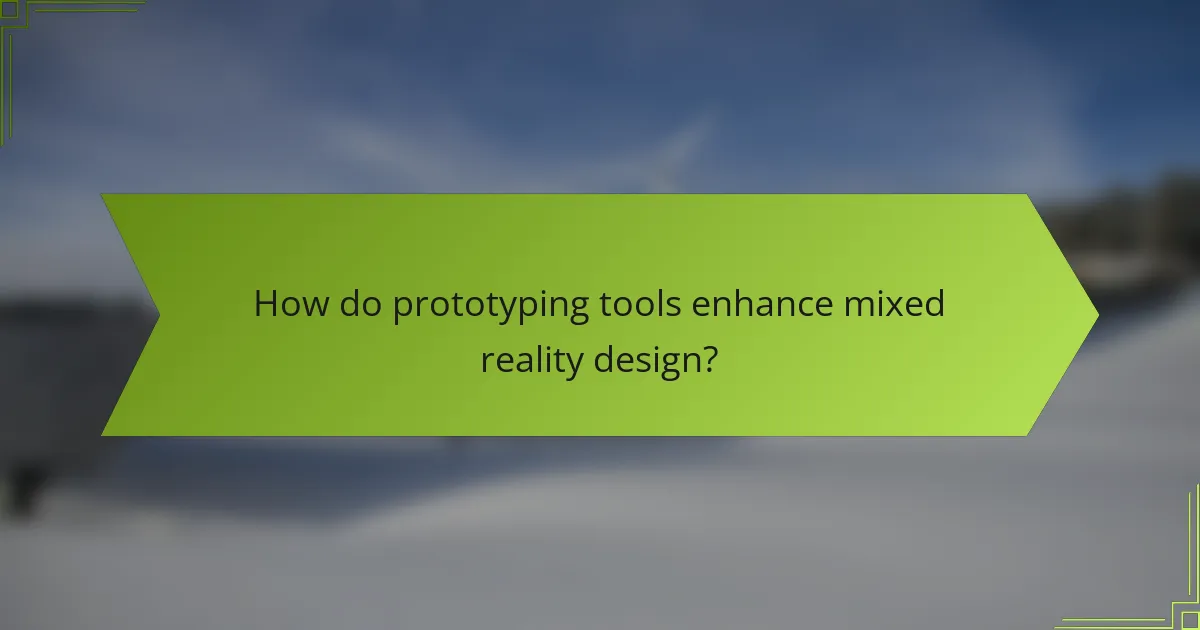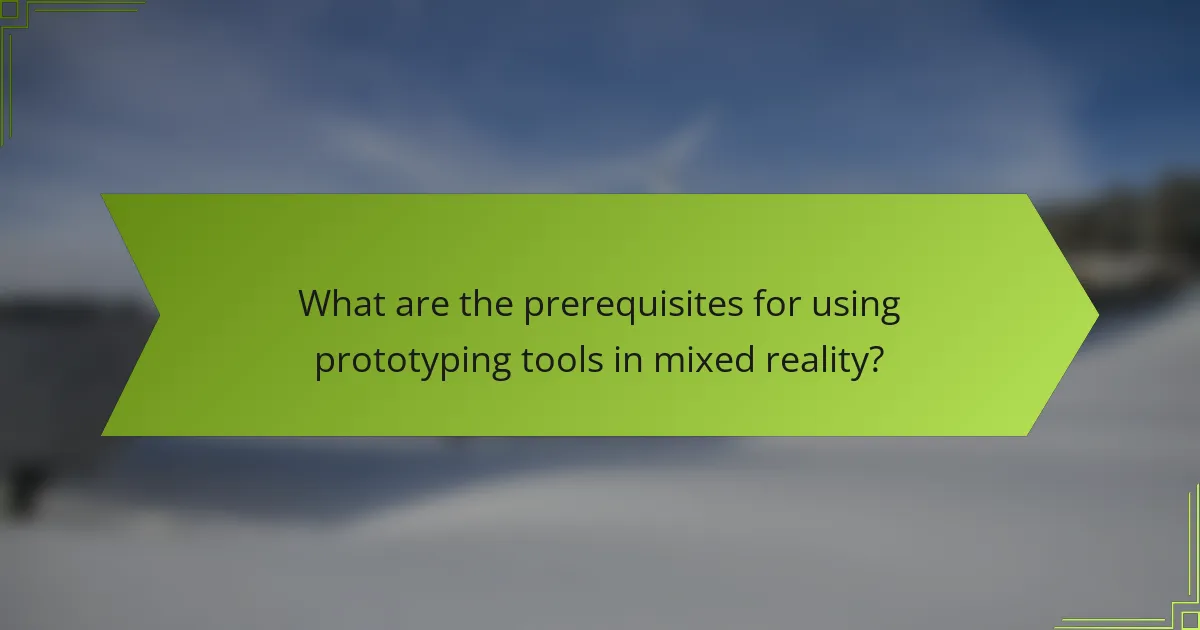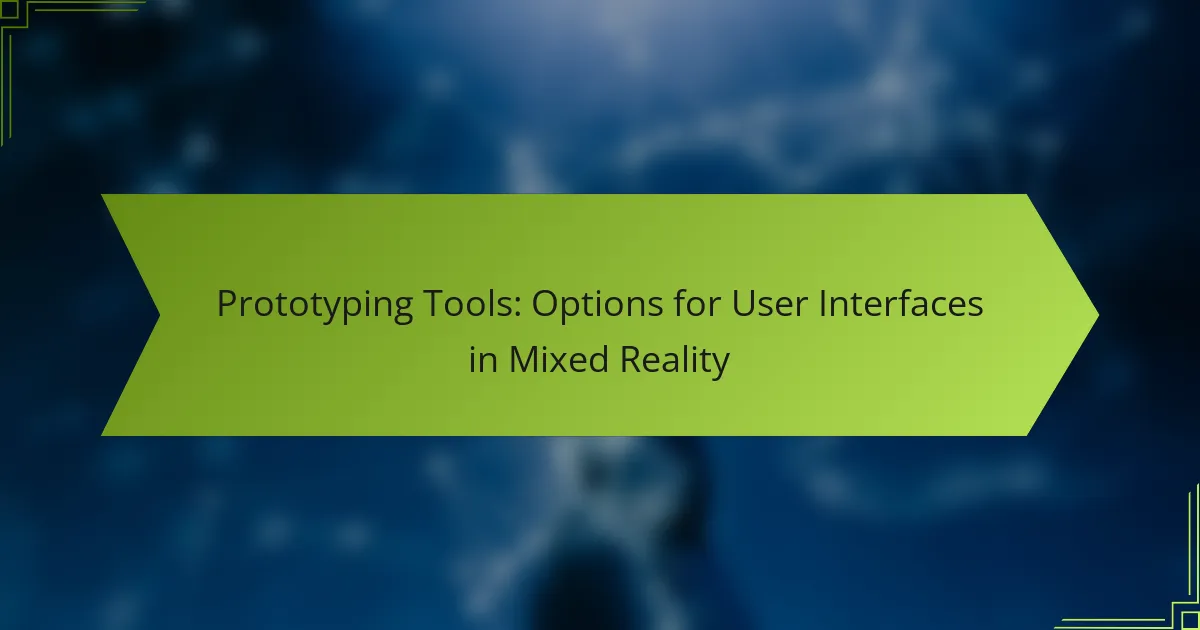Prototyping tools play a crucial role in the design of user interfaces for mixed reality, offering a range of options such as Unity, Adobe XD, Sketch, Figma, and Microsoft Power Apps. These tools enhance the design process by allowing for rapid creation, testing, and refinement of interfaces, ultimately leading to improved collaboration and quicker iterations based on user feedback. When choosing a prototyping tool, it’s essential to consider features that foster collaboration, support various platforms, and integrate well with development environments to ensure an efficient workflow.

What are the best prototyping tools for mixed reality user interfaces?
The best prototyping tools for mixed reality user interfaces include Unity, Adobe XD, Sketch, Figma, and Microsoft Power Apps. Each tool offers unique features that cater to different aspects of the design and development process, making them suitable for various project requirements.
Unity
Unity is a leading platform for developing mixed reality applications, providing robust support for 3D content and interactive experiences. Its extensive library of assets and plugins allows designers to create immersive prototypes that can be tested in real-time.
When using Unity, consider leveraging its built-in physics and lighting systems to enhance realism. Additionally, familiarize yourself with the Unity Asset Store to find resources that can speed up your prototyping process.
Adobe XD
Adobe XD is a versatile design tool that excels in creating wireframes and interactive prototypes for mixed reality interfaces. Its user-friendly interface and integration with other Adobe products facilitate a smooth design workflow.
To make the most of Adobe XD, utilize its voice prototyping features and auto-animate capabilities to simulate user interactions effectively. This can help in visualizing how users will navigate through mixed reality environments.
Sketch
Sketch is a popular vector graphics editor that is widely used for UI design, including mixed reality applications. Its focus on collaboration and plugins enhances the prototyping experience, allowing teams to work together seamlessly.
When using Sketch, consider incorporating plugins like Craft to streamline the design process and create interactive prototypes. This can significantly reduce the time spent on revisions and improve overall efficiency.
Figma
Figma is a cloud-based design tool that supports real-time collaboration, making it ideal for teams working on mixed reality projects. Its prototyping features allow designers to create interactive mockups that can be easily shared and tested.
Leverage Figma’s component system to maintain design consistency across your mixed reality interfaces. Additionally, use its commenting feature to gather feedback from stakeholders directly within the design file.
Microsoft Power Apps
Microsoft Power Apps is a low-code platform that enables users to create custom applications, including those for mixed reality. It is particularly useful for businesses looking to develop internal tools or solutions without extensive programming knowledge.
To effectively use Power Apps for mixed reality, focus on integrating it with other Microsoft services like Azure and SharePoint. This can enhance functionality and streamline data management within your applications.

How do prototyping tools enhance mixed reality design?
Prototyping tools significantly improve mixed reality design by enabling designers to create, test, and refine user interfaces quickly. These tools facilitate a more efficient workflow, allowing for better collaboration and faster iterations based on user insights.
Rapid iteration
Rapid iteration is a key advantage of using prototyping tools in mixed reality design. Designers can quickly create and modify prototypes, allowing for multiple versions to be tested in a short timeframe. This process helps identify usability issues early, reducing the time and cost associated with later-stage revisions.
Tools like Unity and Figma support rapid prototyping by offering drag-and-drop interfaces and reusable components. This enables designers to focus on functionality rather than getting bogged down in technical details.
User feedback integration
Integrating user feedback is crucial for effective mixed reality design, and prototyping tools streamline this process. By allowing users to interact with prototypes, designers can gather valuable insights that inform design choices. This feedback loop helps ensure that the final product aligns with user needs and expectations.
For example, tools such as Adobe XD allow for user testing sessions where participants can provide real-time feedback. This immediate input can lead to significant design improvements and higher user satisfaction.
Realistic simulations
Prototyping tools offer realistic simulations that enhance the mixed reality experience. These simulations allow designers to visualize how users will interact with their interfaces in a virtual environment. This helps in assessing the practicality and effectiveness of design elements before full-scale development.
Tools like SketchUp and Blender can create detailed 3D models that simulate real-world interactions. By testing these models, designers can identify potential issues and refine their interfaces to create a more intuitive user experience.

What features should I look for in mixed reality prototyping tools?
When selecting mixed reality prototyping tools, prioritize features that enhance collaboration, support multiple platforms, and integrate seamlessly with development environments. These capabilities will streamline your design process and ensure a smoother transition from prototype to final product.
Collaboration capabilities
Effective collaboration features are essential in mixed reality prototyping tools, allowing teams to work together in real-time regardless of their physical location. Look for tools that offer shared workspaces, version control, and commenting functionalities to facilitate feedback and discussion.
Consider tools that support both synchronous and asynchronous collaboration. For example, some platforms allow users to leave comments or annotations on prototypes, enabling team members to review and respond at their convenience.
Cross-platform support
Cross-platform support ensures that your prototypes can be accessed and tested on various devices, including VR headsets, AR glasses, and mobile devices. This flexibility is crucial for reaching a broader audience and gathering diverse user feedback.
Check if the prototyping tool is compatible with popular operating systems like Windows, macOS, iOS, and Android. Tools that can export prototypes in multiple formats will also save time and effort when sharing with stakeholders or developers.
Integration with development environments
Integration with existing development environments is a key feature to streamline workflows and reduce friction during the development process. Look for tools that can easily connect with popular software like Unity, Unreal Engine, or other coding platforms.
Tools that offer APIs or plugins for these environments can enhance productivity by allowing designers to hand off prototypes directly to developers without extensive rework. This integration can significantly shorten the time from prototype to production.

What are the pricing options for mixed reality prototyping tools?
Mixed reality prototyping tools offer various pricing options, including free trials, subscription models, and one-time purchase options. Understanding these pricing structures can help you choose the best tool for your needs and budget.
Free trials available
Many mixed reality prototyping tools provide free trials, allowing users to explore features without financial commitment. These trials typically last from a week to a month, giving you ample time to evaluate the software’s capabilities.
During the trial period, focus on key functionalities that matter most to your project, such as user interface design and collaboration features. Be mindful of any limitations, such as restricted access to advanced tools or export options.
Subscription models
Subscription models for mixed reality prototyping tools often come in monthly or annual plans, with prices ranging from low tens to hundreds of USD per month. These plans may include tiered pricing based on features, such as basic access versus premium capabilities.
When considering a subscription, assess the long-term costs versus the benefits. Some tools may offer discounts for annual commitments, which can lead to significant savings if you plan to use the software consistently.
One-time purchase options
One-time purchase options for mixed reality prototyping tools require a single upfront payment, which can range from a few hundred to several thousand USD. This model is appealing for users who prefer not to deal with ongoing subscription fees.
However, keep in mind that one-time purchases may not include regular updates or customer support, which are often part of subscription plans. Evaluate the total cost of ownership, including potential future upgrades, to determine if this option is truly cost-effective for your needs.

What are the prerequisites for using prototyping tools in mixed reality?
To effectively use prototyping tools in mixed reality, users should have a foundational understanding of both user interface design and the specific mixed reality platform they are working with. Familiarity with 3D modeling and interaction design principles is also beneficial.
Technical Skills Required
Prototyping in mixed reality often requires knowledge of programming languages such as C# or JavaScript, depending on the platform. Understanding how to work with development environments like Unity or Unreal Engine is crucial for creating interactive experiences.
Additionally, skills in 3D modeling software, such as Blender or Maya, can enhance the quality of prototypes. Users should be comfortable navigating these tools to create and manipulate 3D assets effectively.
Understanding Mixed Reality Concepts
A solid grasp of mixed reality concepts, including spatial awareness and user interaction paradigms, is essential. This understanding helps in designing intuitive interfaces that leverage the unique capabilities of mixed reality environments.
Familiarity with user-centered design principles will guide the creation of prototypes that meet user needs and expectations. Focusing on how users will interact with virtual elements in a physical space is key.
Hardware and Software Requirements
Users need access to the appropriate hardware, such as headsets like the Microsoft HoloLens or Meta Quest, which support mixed reality experiences. Ensure that the computer or device used for development meets the software requirements for the chosen prototyping tools.
Software tools should be compatible with the target hardware and provide features for testing and iteration. Popular options include tools like Sketch, Figma, and Adobe XD, which can be integrated with mixed reality platforms for seamless prototyping.
